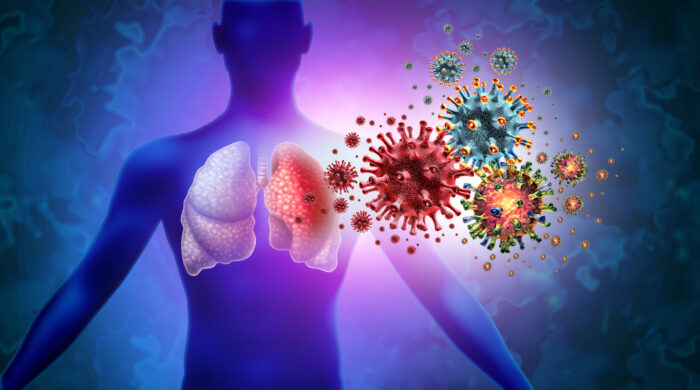Have you ever been sick and unsure what kind of treatment would help you feel better? While some illnesses caused by viruses and bacteria may have similar symptoms, their causes and treatments differ. Knowing the difference between these two types of infections is important so you can get the treatment that addresses the root cause of your symptoms.
Let’s explore the differences between viral and bacterial infections, and explain how health providers determine the appropriate treatments to help you feel well again.
What are Viral Infections?
Viruses are tiny infectious agents that invade living cells, then grow and replicate inside the host. Common viral infections include the flu, seasonal cold, measles, chickenpox and COVID-19.
What are Bacterial Infections?
Bacteria are single-celled microorganisms that infect the body through various means such as inhalation, ingestion or contact with contaminated surfaces. Once inside the body, bacteria can multiply and cause damage to tissues and organs. Common bacterial infections include food poisoning, strep throat, urinary tract infections, and pneumonia.
Differences between Viral and Bacterial Infections
Transmission, symptoms and treatment for viral and bacterial infections differ in a variety of ways.
Transmission
Viral infections are often spread through respiratory droplets, such as when an infected person coughs or sneezes and another person inhales these droplets.
Bacterial infections are transmitted through ingestion of contaminated food or water, contact with contaminated surfaces, or bites from infected animals or insects.
Symptoms
Symptoms of viral infections can range from mild to severe and may include the following:
- Fever
- Cough
- Runny nose
- Body aches
- Fatigue
- Rash
Symptoms of bacterial infections can vary depending on the type of infection and may include the following:
- Fever
- Chills
- Fatigue
- Nausea
- Vomiting
- Diarrhea
Treatment of Viral vs Bacterial Infections
Treatment for viral infections varies depending on the type of virus and the severity of sickness. Some viral infections can be managed with rest and over-the-counter medications to relieve symptoms, while others such as COVID, herpes, hepatitis, and HIV may require antiviral drugs or hospitalization.
Vaccines can help prevent disease onset or moderate the severity of symptoms when someone gets infected with a virus. Currently, vaccines are available for some viral infections such as the flu, COVID-19 and HPV.
Treatment for bacterial infections typically involves antibiotics, which can kill or inhibit the growth of microorganisms in your body. While antibiotics are effective at treating bacterial infections, they are not effective at treating viruses.
Overuse or misuse of antibiotics can have long-term negative effects, so it is important to consult with your primary care provider and carefully follow the directions on your antibiotic prescription to ensure you complete the full course of treatment.
Diagnosing of Infections
To determine whether an infection is viral or bacterial, your primary care provider may perform diagnostic tests, such as blood tests, urine tests, or cultures of bodily fluids, to identify the specific pathogen causing the illness. Some diagnostic tests, such as rapid antigen tests or PCR tests, can provide quick results and help guide treatment decisions.
In some cases, providers may also use imaging tests, such as X-rays or CT scans, to evaluate the extent of the infection or to identify complications. Once the pathogen causing the infection is identified, doctors can determine the appropriate treatment. Antibiotics are typically used to treat bacterial infections, while antiviral medications may be used to treat viral infections.
However, some infections may be caused by both bacteria and viruses. On occasion, it may be difficult to distinguish between the two and requires a combination of treatments and supportive care to manage symptoms and prevent complications. It’s important to follow the advice of your provider regarding treatment options for any suspected infection.
How to Prevent Viral and Bacterial Infections
There are several steps individuals can take to prevent both viral and bacterial infections.
- Hygiene: Adopt personal hygiene practices such as washing hands regularly, covering the mouth and nose when coughing or sneezing, and avoiding close contact with sick individuals. At home, help prevent the spread of infections through regular hygiene practices such as cleaning and disinfecting frequently touched surfaces.
- Vaccines: Vaccinations are another important tool in preventing viral and bacterial infections. Vaccines work by training the immune system to recognize and fight off specific pathogens, reducing the risk of infection and its complications. Vaccinations are especially important for vulnerable populations, such as young children, elderly individuals, and those with weakened immune systems who may be at higher risk for severe illness. Questions about vaccines? Talk to a WWMG primary care provider.
When to Seek Medical Help
It’s important to seek medical attention if you suspect you might have an infection. Prompt diagnosis and treatment can help prevent health complications and the spread of infection to others. By following good hygiene practices, getting vaccinated, and seeking appropriate medical care, you can reduce your risk of getting and spreading both viral and bacterial infections, and support your continued good health.
If you aren’t feeling well, request an appointment today with a WWMG primary care provider. Appointments are available at any of our 7 primary care locations.
